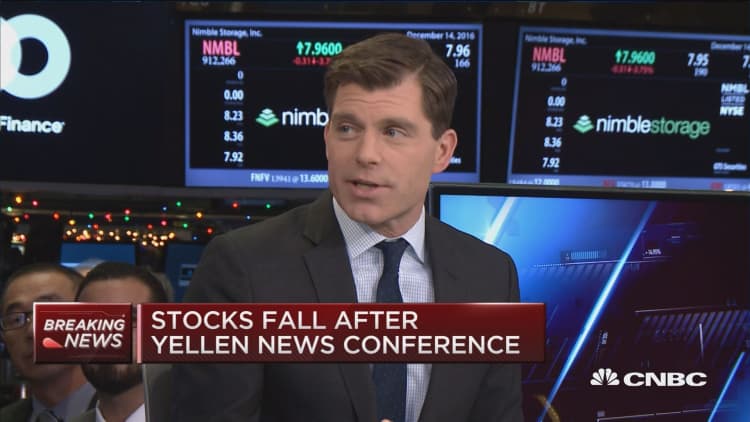
Here's what I'm watching going into the closing bell...
Overbought market
The market rolled into the Fed decision a bit tired – but it came by the fatigue honestly, by covering an awful lot of ground in a short period of time without many breaks along the way. Everyone is citing the unusually stretched "overbought" readings, the fully contented investor sentiment indicators, the heavy flows into the ETFs covering the hottest sectors (small caps, financials, industrials). These all are just different ways of expressing that stocks have had a blistering run that prompted many to chase it for a few weeks, and it would take almost any excuse at all for the market to churn for a while or retreat a bit.
Dow 20,000 angst
The Dow tagging 20,000 is probably not a great excuse, but after this run the landmark would accentuate the distance traveled to a double-digit year-to-date gain. The Dow traded under 16,000 eight months ago, let's not forget. Are we building up some pent-up selling to be released in January? Maybe. Market breadth started the day soft (about one-third of all volume in advancing stocks) and has stayed there. Growth again outperforming in this rotation, and strength in bank stocks was short-loved. We'll see if it turns into a fuller profit-taking day.
Santa rally?
Almanac devotees point out that the true definition of the Santa rally is the final five days of the year plus the first two in January. The past two years, that short stretch of the calendar was negative, which is a time-honored warning sign for January. So we'll have to wait a few weeks to get this hoary verdict rendered. On the way there, investors seem not to be overthinking things for the moment – trends in risk assets are higher, the seasonal bias is to the upside, and many spent November feeling badly underexposed to stocks, so it would probably take a dramatic shift to make them suddenly feel overloaded with equities so quickly.
Bonds giving the OK
The largest and most crucial distinction between now and when the Fed lifted rates one year ago is the robust health of the credit markets right now. A year ago, junk bonds were under significant stress as oil crashed and the global industrial economy was retrenching. Today, junk spreads are tighter than they've been since September 2014, not far from the strongest readings of this cycle in June 2014. Maybe the high-yield market has somehow got it wrong this time, but it's more often a reliable beacon of underlying financial conditions than a balky signal. I always say, the stock market is the bond market's not-so-smart kid brother – impulsive, suggestible and late to grasp new ideas. Right now, the older sibling is telling you thinks look OK, so long as the macro data don't fall apart soon.
Market was expecting 3 hikes
The Fed's modest step toward more possible tightening in 2017 roughly tracks the markets' emerging view. It'll take a while for the Fed narrative to swing toward a "behind the curve" theme if it ever happens this cycle. Probably not bad that Treasury yields rose a bit on the FOMC news. So long as the 10-year doesn't rush above 2.75 percent or so, stocks should be able to hold it together. Longer-term, if the economy and policy come through as hoped, 3 percent would be OK – eventually.
German rates
On the list of things not getting attention but might soon? The German 10-year bond yield is at its lows (most negative) and the spread to Treasurys is pulled pretty taut here. The kind of thing that matters only when it does. Emerging-markets index futures (and the EEM ETF) down 2 percent as the dollar rallies. Need to watch whether this muscle memory kicks in more strenuously.


